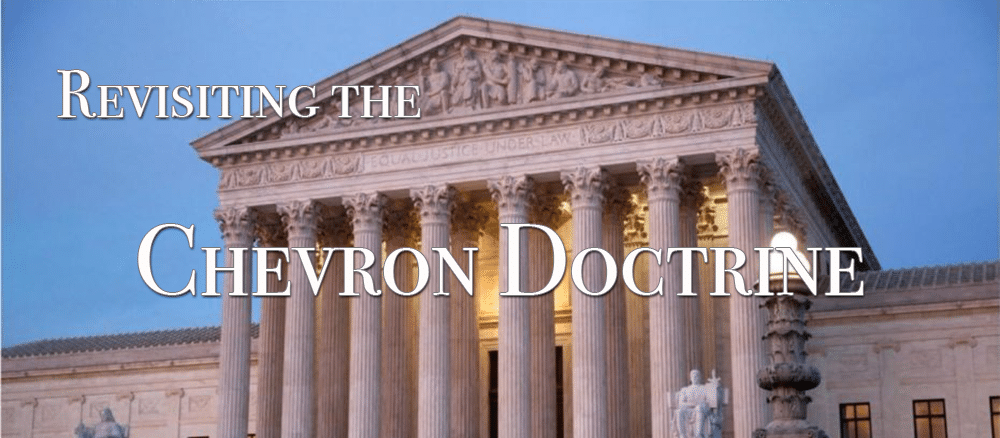Netting Justice: Fishermen’s Court Battle Could Put A STOP to ATF Overreach

This is a fish story that could have seismic impacts on the way the federal government generates gun control regulations.
The U.S. Supreme Court heard arguments in two cases – both challenging a National Marine Fisheries Service rule that requires commercial fishing boats to pay for government monitors that keep watch over crews for overfishing violations. That rule not only requires fishing boat captains to allow the government monitors on board the vessels while underway but also requires the fishing crews to bear the daily costs of the federal watchdog on their decks.
The cases are Loper Bright Enterprises v. Raimondo and Relentless, Inc. v. Department of Commerce. The cases ask the Supreme Court to consider more than just the question of whether the government can force a private enterprise to bear the monetary costs of accommodating a government function. It challenges what’s referred to as the Chevron doctrine, a legal doctrine that arose from a previous Supreme Court decision that has over time given wide swath to federal agencies to sort of fill in the holes – if you will – of how the government is to enforce a law when the statute passed by Congress doesn’t explicitly dictate it. It basically allows unelected federal bureaucrats to create laws. Under the Chevron Doctrine, the federal judiciary gives deference to federal agencies’ interpretation of the law, and some would argue abdicate their constitutional responsibility to say what the law means. Chevron deference is the lifeblood of the “administrative state.”
“The dispute at the center of these lawsuits is real, however, and it illustrates how vulnerable Americans are to the whims of federal agencies empowered to invent their own authority,” wrote Jacob Sullum, in AmmoLand News.
Based on the justices’ questions, it appears the Supreme Court might be ready to neuter the doctrine, if they don’t abolish it altogether. The Hill reported several justices appeared to question the Chevron doctrine’s dominance. Justice Neil Gorsuch described the doctrine as “The government always wins.” Justices also argued that the Chevron Doctrine has given the Executive Branch “a wide license to flip-flop on its interpretations of statutes to fit its policy goals.” [Sounds like ATF?]
That’s evident when examining the way in which the Biden-Harris administration has been using executive overreach as a weapon against the firearm industry.
Chevron Doctrine & Gun Control
The Chevron doctrine stemmed from the 1984 opinion in Chevron v. Natural Resources Defense Council that upheld a regulation published by the Environmental Protection Agency (EPA). The opinion set up a two-part test to determine if an agency’s administration of a rule passes muster. The opinion noted that the Court must first determine whether Congress directly addressed the question in the case and if it didn’t, the administrative rule enforcing it would be legal so long as it was “reasonable.”
That gave wide latitude for federal agencies to publish their own rules on how they believed they should interpret laws passed by Congress. That has reached a tipping point, not just with the EPA or the National Marine Fisheries Service. The firearm industry has witnessed the abuse of executive authority, too. There are cases challenging Final Rules published by the Bureau of Alcohol, Tobacco, Firearms and Explosives (ATF) that argue the agency charged with regulating firearms in the United States has overstepped the authority granted by Congress to create their own criminal laws.
Garland v. Cargill was granted review by the U.S. Supreme Court challenging the ATF’s Final Rule that reclassified bump stocks as a “machinegun” under federal law. That case is set to be heard by the Supreme Court on Feb. 28. The U.S. Court of Appeals for the Fifth Circuit held that ATF exceeded their authority when officials published a Final Rule redefining what constitutes a “frame or receiver” in the Biden administration’s attempt to ban the ability of Americans to make their own privately-made firearms.
Judge Kurt D. Engelhardt wrote in a 3-0 opinion, “ATF, in promulgating its Final Rule, attempted to take on the mantle of Congress to ‘do something’ with respect to gun control. But it is not the province of an executive agency to write laws for our nation. That vital duty, for better or for worse, lies solely with the legislature.”
Pattern of Chevron Abuse
In other words, the ATF can’t make up its own criminal law, just because they want to.
The Fifth Circuit court, again, ruled that ATF also exceeded their authority when they published a Final Rule banning stabilizing braces for AR-15 pistols. The court found that the ATF didn’t provide sufficient opportunity for the public to offer comment. The court panel sent the case back to a U.S. District Court, which later issued a nationwide injunction against ATF enforcing the rule while the challenge proceeds through the courts.
It is a near certainty that the ATF’s Proposed Rule to redefine “engaged in the business” will be challenged in court. The public comment period closed, with NSSF opposing the proposed rule in public comment, and a Final Rule is expected to be published soon. There’s no expectation that the Biden administration will step back from their effort to require hundreds of thousands of private gun sellers to obtain a federal firearms license and be required to maintain records ready for ATF inspection. That also amounts to a giant step closer to national firearm registry, since each private seller would be required to maintain those ATF Form 4473s in perpetuity or transfer them to the ATF when they surrender their license. The White House said at the time it announced ATF would issue its “engaged in business” rule that it would be a step toward “Universal Background Checks” that Congress has expressly rejected.
Reason for Skepticism
The irony is there was no mandate for ATF to redefine what it means to be “engaged in the business.” Congress spoke clearly when they addressed the definition in the Bipartisan Safer Communities Act (BSCA). Congress made a one-word change to the “engaged in the business” definition by removing the word “livelihood” the courts had effectively read out of the statute. The law still defines a firearm dealer as, “a person who devotes time, attention and labor to dealing in firearms as a regular course of trade or business to predominantly earn a profit through the repetitive purchase and resale of firearms, but such term shall not include a person who makes occasional sales, exchanges, or purchases of firearms for the enhancement of a personal collection or for a hobby, or who sells all or part of his personal collection of firearms.”
In the anticipated challenge to ATF’s final rule the Biden administration will assuredly rely upon the Chevron doctrine to say the law wasn’t clear and ATF needed to “interpret” it to enforce the law. What Congress did with a one-word change, the ATF took 108 pages of legal backflips to justify.
It’s clear that Supreme Court justices are skeptical of the Chevron doctrine. Politico reported that Justice Neil Gorsuch wrote in 2022 that the Chevron doctrine, “deserves a tombstone no one can miss.” Justice Samuel Alito wrote in 2018 that it is an “increasingly maligned precedent,” Justice Brett Kavanaugh wrote in 2016 that the doctrine is “a judicially orchestrated shift of power from Congress to the Executive Branch,” Justice Clarence Thomas wrote in a 2015 concurrence that “the potentially unconstitutional delegations we have come to countenance in the name of Chevron deference,” emboldened the EPA to exceed its authority, leaving him “alarmed.”
Decisions in both cases are expected in June.
Read Related:
- Dump the Chevron Doctrine: Why? Because Freedom Is The Default Position
- Chevron Deference Violates the Constitution, Argues FPC to Supreme Court
- Excessive Judicial Deference Gives Rogue Agencies a License to Rewrite the Law in Their Favor
About The National Shooting Sports Foundation
NSSF is the trade association for the firearm industry. Its mission is to promote, protect and preserve hunting and shooting sports. Formed in 1961, NSSF has a membership of thousands of manufacturers, distributors, firearm retailers, shooting ranges, sportsmen’s organizations, and publishers nationwide. For more information, visit nssf.org




